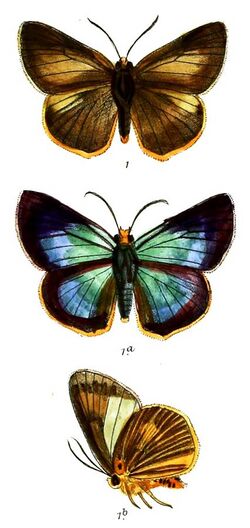Biology:Bibasis harisa
| Orange awlet | |
|---|---|

| |
| Male (top), female and male underwing | |
| Scientific classification | |
| Domain: | Eukaryota |
| Kingdom: | Animalia |
| Phylum: | Arthropoda |
| Class: | Insecta |
| Order: | Lepidoptera |
| Family: | Hesperiidae |
| Genus: | Bibasis |
| Species: | B. harisa
|
| Binomial name | |
| Bibasis harisa (de Niceville, 1883)[1]
| |
| Synonyms | |
|
Ismene harisa de Niceville, 1883[1] | |
Bibasis harisa, the orange awlet,[2] is a species of hesperid found in Asia. The butterfly was reassigned to genus Burara by Vane-Wright and de Jong (2003) and is considered by them to be Burara harisa.[3]
Range
The orange awlet is found in India , Myanmar, Malaysia, Java, Singapore, Hong Kong and north Vietnam.[2]
In India, the butterfly is found along the Himalayas from Sikkim to Assam and eastwards to south Myanmar. It also has been recorded from the Andaman islands.[2][4]
The type locality is Bengal.[2]
Status
It is considered by William Harry Evans to be very rare in Hong Kong, rare in South India, but not rare in the Himalayas.[4]
Description
The butterfly has a wingspan of 45 to 55 mm.[4]
Edward Yerbury Watson (1891) gives a detailed description:[5]
Male and female brown.Male. Upperside dull vinaceous brown, palest on the disk; forewing with an orange yellow costal streak; hindwing broadly along anterior margin pale buff yellow. Body greyish. Cilia of hindwing orange yellow. Underside paler suffused with orange yellow; forewing with a curved series of pale purple narrow streaks between the veins before the apex, and a broad pale buff patch along the posterior margin; hindwing with the veins and lines between them and cilia orange yellow: a black orange yellow encircled basal spot on both wings; a discal series of pale purplish streaks. Third joint of palpi brown; palpi beneath, front and sides of thorax, legs and streak alongside of abdomen orange yellow; middle of thorax and abdomen and anal tuft orange yellow.
Female. Upperside dark purple brown; the base of wings greyish, with steel blue gloss. Body greyish. Cilia of hindwing pale orange yellow. Underside as in male; posterior margin of forewing with a less defined pale patch.—Watson
Habits
This butterfly is crepuscular.[3]
Host plants
The larva has been recorded on Zingiber zerumbet (Zingiberaceae).[2]
Cited references
- ↑ 1.0 1.1 Beccaloni, G.; Scoble, M.; Kitching, I. et al., eds (2003). "Bibasis harisa". The Global Lepidoptera Names Index. Natural History Museum. https://www.nhm.ac.uk/our-science/data/lepindex/detail/?taxonno=181346. Retrieved April 19, 2018.
- ↑ 2.0 2.1 2.2 2.3 2.4 Markku Savela's website on Lepidoptera Page on genus Bibasis.
- ↑ 3.0 3.1 Vane-Wright and de Jong (2003) (see TOL web pages on genus Bibasis and genus Burara in the Tree of Life Web Project) state that Bibasis contains just three diurnal species, the crepuscular remainder having been removed to Burara. The species now shifted to Burara are morphologically and behaviorally distinct from Bibasis, within which many authors have formerly included them.
- ↑ 4.0 4.1 4.2 Evans, W.H. (1932). The Identification of Indian Butterflies (2nd ed.). Mumbai, India: Bombay Natural History Society. pp. 318–319, ser no I 2.13.
- ↑ Watson, E. Y. (1891) Hesperiidae indicae.
References
- Evans, W.H. (1932). The Identification of Indian Butterflies (2nd ed.). Mumbai, India: Bombay Natural History Society.
- Watson, E. Y. (1891) Hesperiidae indicae. Vest and Co. Madras.
Online
- Beccaloni, George; Scoble, Malcolm; Kitching, Ian; Simonsen, Thomas; Robinson, Gaden; Pitkin, Brian; Hine, Adrian; Lyal, Chris. "The Global Lepidoptera Names Index (LepIndex)". Natural History Museum, London. http://www.nhm.ac.uk/our-science/data/lepindex/.
- Brower, Andrew V. Z. and Warren, Andrew, (2007). Coeliadinae Evans 1937. Version 21 February 2007 (temporary). http://tolweb.org/Coeliadinae/12150/2007.02.21 in The Tree of Life Web Project, http://tolweb.org/
- "Markku Savela's website on Lepidoptera". http://www.nic.funet.fi/pub/sci/bio/life/insecta/lepidoptera/.
Wikidata ☰ Q3595430 entry
 |

